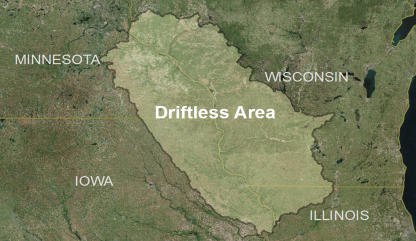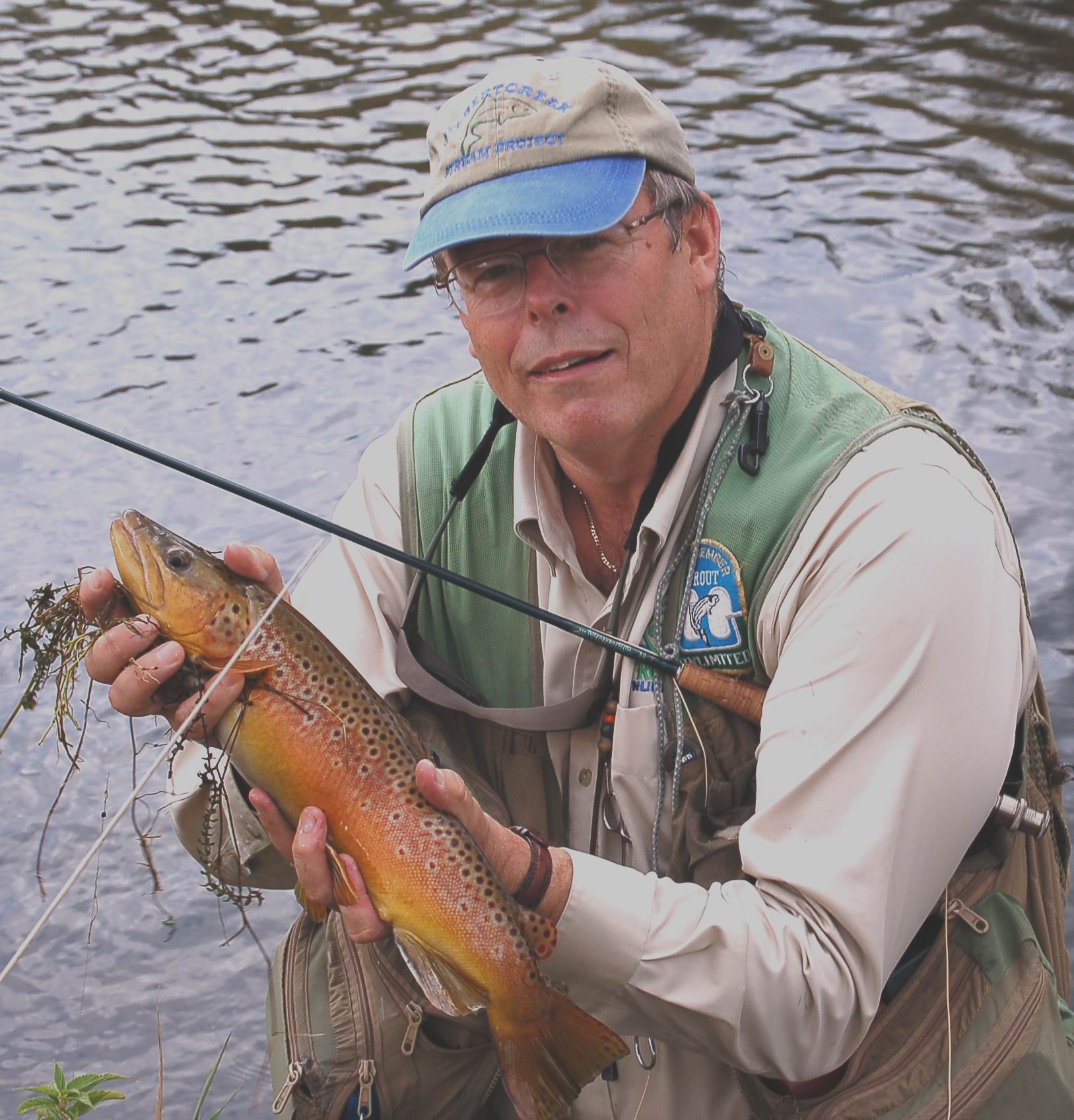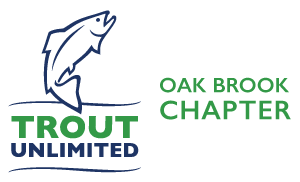AN INTERVIEW WITH DUKE WELTER ON THE DRIFTLESS AREA CONSERVATION INITIATIVES
By Jim Schmiedeskamp
Published March 2018
Here’s my interview with Duke Welter, TUDARE’s Outreach Coordinator, after he spoke to the Oak Brook Trout Unlimited Chapter on February 21, 2018.
Spearheaded by Trout Unlimited, the Driftless Area Restoration Effort is a locally driven effort to protect, restore, and enhance rivers and streams for fish and other aquatic life throughout the four-state Driftless Area.
TU’s Driftless Area Restoration Effort, (TUDARE) is an initiative Duke Welter helped found back in 2003. As TUDARE’s Outreach Coordinator, Duke travels the four-state region regularly, getting the word out about the great trout waters in the unglaciated area. He fishes with reporters, with policy makers, with students, with teachers, with project volunteers, and on his days off he fishes where projects might help, and where they already have helped produce healthy fisheries.
Before Duke went to work for TU in 2010, he served as vice-chair of its National Board of Trustees and as chair of its National Leadership Council, the grassroots leadership body of TU. He has been active in conservation efforts and advocacy for over 30 years, working on groundwater protection, protecting rivers from mining impacts, removing small dams, wetland and river restoration, regional watershed issues, public lands access and funding for natural resource management. For his conservation work he was recognized by the River Alliance of Wisconsin as a “River Champion of the Decade” in 2003, by Trout Unlimited as its “National Conservation Volunteer of the Year” in 2002, and with TU’s highest award for volunteer leadership in 2011.
OBTU: SINCE HELPING TO FOUND THE TU’S DRIFTLESS AREA RESTORATION EFFORT ( TUDARE) in 2003-2004, WHAT WOULD YOU IDENTIFY AS THE ORGANIZATION’S TOP ACCOMPLISHMENT’S OVER THE PAST 15 YEARS?
DUKE: TUDARE started with the goals of ramping up restoration capacity across the region, strengthening TU chapters by offering them more opportunity to carry out projects and raising public recognition of the region’s identity. With a whole raft of partners, I think we’ve done pretty well. We’ve trained over 500 volunteers from TU chapters and a lot of other groups on how to put together restoration projects. Together we’ve put over $60 million into such projects, and added over 450 miles of legal public fishing access. And the public, I think, better appreciates the quality of this resource and the over $1 billion a year angling brings to a rural region with a lot of poverty.
OBTU: OVERALL, HOW WOULD YOU GRADE THE CURRENT STATE OF THE WISCONSIN DRIFTLESS AREA IN TERMS OF WATER/STREAM QUALITY AND FISHING CONDITIONS? (PROVIDE A LETTER GRADE FOR BOTH).
DUKE: Water quality, I believe, has suffered somewhat in the past 10 years with the corn/soybean boom. Many conservation practices were shelved when corn hit $7.50 a bushel and thousands of acres were taken out of conservation use. Widespread tiling of fields created a straight shot for drainage into streams, and this carried plenty of nitrates and phosphorus into streams. I’d say water quality fell off somewhat. I’d give it a grade of “B” right now. We can do better.
Fishing conditions have continued to improve in many areas as habitat work has expanded. I’d venture to give fishing conditions an “A-”. These streams are very productive if you give them half a chance with good habitat.
OBTU: WHAT DO YOU SEE AS TUDARE’s TOP THREE PRIORITIES OVER THE NEXT 10 YEARS? DUKE: First, our streams have been battered by dramatic rain events the last 10 years; we had more 100-year and 500-year events than would be expected. As our climate changes, our approaches to land use and restoration need to adapt. Second, warming summer seasons and milder winters will make our streams more drought-prone. To buffer against those conditions, we need to better understand and protect our groundwater. Third, a challenge from industrial-scale farming could mean more insults to that groundwater and eventually surface waters from nutrient runoff. We need to be vigilant about what’s running off and enforce rules meant to protect these waters.
OBTU: HOW WOULD KYOU DESCRIBE YOUR CURRENT JOB AS THE TUDARE OUTREACH COORDINATOR AND WHAT DO YOU ENJOY THE MOST ABOUT IT? SINCE TAKING ON THIS NEW ROLE IN 2010, HOW MANY MILES DO YOU RACK UP ON YOUR ODOMETER ANNUALLY?
DUKE: I travel about 35,000 miles a year, mostly in the four-state area. My work, which I enjoy very much, is aimed at spreading the word about TUDARE and the Driftless Area as a region. It’s a compelling story and I enjoy speaking with groups, media and policy makers about what healing can be done and what benefits can come from healthy coldwater streams.
OBTU: THE DRIFTLESS AREA SPANS A FOUR-STATE REGION CONSISTING OF SOUTHWEST WISCOSIN, SOUTHEAST MINNESOTA, NORTHEAST IOWA AND NORTHWEST ILLINOIS. ARE THERE ACTUALLY COLDWATER STREAMS HOLDIG FISHABLE TROUT POPULATIONS IN ILLINOIS? IF YES, WHAT STREAMS COULD USE SOME RESTORATION WORK BY ILLINOIS TU CHAPTERS?
DUKE: It is very possible we can find coldwater streams, or at least potentially cold water streams, in Northwest Illinois. However, information is lacking as none of those streams offer public access and thus aren’t open to research aimed at potential management actions. If we can find some landowners willing to afford access and perhaps allow restoration, I believe the record elsewhere suggests we will be able to have some healthy trout water in Illinois. Remember that these streams across the Driftless Area were not healthy 30 or 40 years ago, and that restoration work resulted in a dramatically swift recovery. Can we do it in Illinois? Find us a water with that potential and let us give it a try.
OBTU: DURING YOUR FEBRUARY 21 OBTU CHAPTER PRESENTATION, YOU MENTIONED THE RECENT FULL-TIME ADDITIOH OF A TU PROJECT SPECIALIST (PAUL KRAHN) WHO HAS UNDERTAKEN 16 DRIFTLESS AREA PROJECTS IN HIS FIRST YEAR. HOW ARE PROJECTS IDENTIFIED AND PRIORITIZED? WHERE DOES THE FUNDING COME FROM?
DUKE: We have had certain streams in our sights for some time, but for some reason projects haven’t resulted there. Maybe an agency doesn’t have resources to do or plan a project, or contact landowners about putting one together. Paul’s very good with people and knows how to design and carry out restoration projects. We intend to keep his plate very full in this target-rich environment.
Funding for projects often starts with the lion’s share coming from the USDA’s Natural Resources Conservation Service, whose missions are reducing erosion from agricultural lands, keeping those agriculture lands in production, and reducing challenges to water quality. Often those dollars are augmented by state trout stamp or license fee dollars, and grants from foundations or businesses or individual donors. In Minnesota, MNTU spends about $1.5 million a year in sales tax earmarked for conservation. The Fish & Wildlife Service supports projects that benefit nongame species like turtles, snakes, birds. And NRCS supports plantings that benefit pollinators like monarch butterflies and migrating or resident songbirds.
OBTU: TUDARE INTRODUCED A RIPARIAN HABITAT GUIDEIN 2007 THAT PROVIDES DETAILED INFORMATION ABOUT THE HABITAT NEEDS OF A WIDE VARIETY OF DRIFTLESS AREA NON-GAME FISH, AMPHIBIAN, INVERTEBRATE, REPTILE, BIRD AND MAMMAL SPECIES. THE GUIDE DESCRIBES SPECIFIC HABITAT FEATURES AND PROVIDES ASSOCIATED DESIGNS THAT CAN BE INTEGRATED INTO UPLAND, RIPARIAN, WETLAND AND IN-STREAM PROJECTS WHERE APPROPRIATE. WEISTER CREEK IN WISCONSIN’S DRIFTLESS AREA—WHICH OBTU HAS SPONSORED WITH FINANCIAL GRANTS OVER THE LAST TWO YEARS—HAS INCORPORATED MANY OF THESE RIPARIAN HABITAT GUIDELINES. HOW SUCCESSFUL HAS THE RIPARIAN HABITAT APPROACH BEEN SINCE ITS INTRODUCTION 10 YEARS AGO?
DUKE: These practices have been installed on many TUDARE projects, and I’m aware that anecdotally some of the herpetologists and other naturalists are pleased with their effectiveness. However, I’m not conversant with efforts to empirically measure that effectiveness. We are working to build in those measures in the future.
OBTU: WHAT DO YOU LIKE TO DO FOR HOBBIES AND VACATION?
DUKE: As a lifelong outdoors enthusiast, I have been exploring the natural world since I was a little boy. That’s led to camping, fishing, hunting, paddling and biking adventures, which I will continue as long as I am able. It’s also led me to skiing, both cross-country (five Birkebeiners and a lot of kilometers on the trail) and downhill (53 years, with 40 years as a ski patroller in the Upper Peninsula of Michigan). Travel has been a lifelong pleasure, including fishing on three continents and a fourth in the planning stage. Reading, writing, fly-tying and music are my indoor pleasures.


